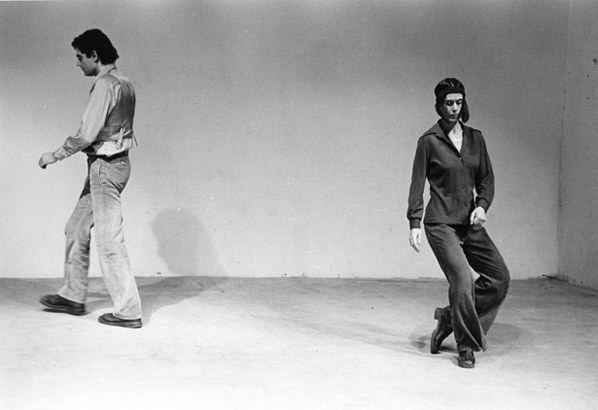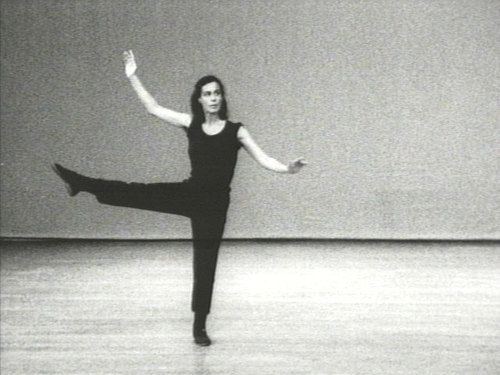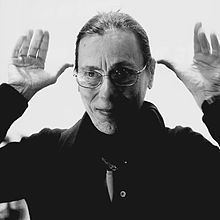Nationality American Name Yvonne Rainer | Role Dancer Siblings Ivan Rainer | |
 | ||
Movies Lives of Performers, The Man Who Envied Women Parents Joseph Rainer, Jeanette Rainer Books Feelings are facts, A Woman Who‑‑: Essays - I, Yvonne Rainer, Poems, The films of Yvonne Rainer Similar People Babette Mangolte, Martha Graham, Joan Jonas, Vito Acconci, Lynn Hershman Leeson | ||
Talking dance yvonne rainer and sally banes
Yvonne Rainer (born November 24, 1934) is an American dancer, choreographer, and filmmaker, whose work in these disciplines is regarded as challenging and experimental. Her work is sometimes classified as minimalist art. Rainer currently lives and works in California and New York.
Contents
- Talking dance yvonne rainer and sally banes
- Yvonne rainer the concept of dust artist profiles
- Early life
- Dance and choreographic work
- Select choreography
- Cinematic work
- Select filmography
- Return to Dance
- Feminism
- Recognition
- References

Yvonne rainer the concept of dust artist profiles
Early life

Yvonne Rainer was born on November 24, 1934 in San Francisco, California. Rainer's parents, Joseph and Jeanette, considered themselves radicals. Her mother was of Polish-Jewish descent and her father of Italian ancestry. As a child, she was sent to live at Sunnyside, a boarding institution in Palo Alto, with her older brother Ivan for several years. Her parents visited them each Sunday in their 1938 Pontiac Sedan. By 1941, she moved back with her parents at the age of seven to a new house in the Sunset that she describes as "an unfamiliar neighborhood of white Protestant working class families." From the age of twelve, she had been "exposed to the heady commingling of poets, painters, writers, and Italian anarchists." She went to Lowell High, and after graduation, she attended San Francisco Junior College for a year, then Berkeley for a week. She dropped out of college by the end of September 1952.

At a very young age, her father introduced her to films, while her mother introduced her to ballet. While she was still at Sunnyside, her mother enrolled her in dance classes. Rainer writes,

I am five or six when my mother enrolls me in a dance school a few blocks from Sunnyside. After being taken to the school several times, I am expected to walk there by myself once a week...All the little girls are able to touch the backs of their heads with their toes. It seems to me that I am the only one who can't.
Rainer found herself hanging out at the Cellar around 1955, where she would listen to poets accompanied by cool jazz. It was here that she met Al Held, a painter. He introduced her to various artists who were natives of New York. It was in August 1956, that she followed Al to New York at the age of twenty-two.
I remember walking down 5th Avenue past Madison Square Park, overwhelmed by an ineffable sense of infinite possibility. Someone else might have described it as a 'conquer-the-world' kind of feeling. For me it was simply pure open-minded excitement. Though I had no idea what the future held, it was already signalling with open arms.
It was Dolly Casella, a close friend, who introduced Rainer to the dance classes of Edith Stephen, a modern dancer. She went to her first adult dance class with Stephen who told her that she was not very "turned out." Rainer admits, "What she didn't say was something that I would gradually recognize in the next couple of years, that my lack of turn-out and limberness coupled with a long back and short legs would reduce my chances of performing with any established dance company." In 1959, she began studying at the Martha Graham School. She later studied with James Waring and Merce Cunningham.
Dance and choreographic work
In 1962, at the age of 27, Rainer approached the Reverend Al Carmines with dancers Steve Paxton and Ruth Emerson to ask if they could begin performing at the Judson Memorial Church, founding the Judson Dance Theater. The Judson Dance Theatre was a focal point for vanguard activity in the postmodern dance world throughout the 1960s, and Rainer formed her own company after the Judson performances ended. Rainer is noted for an approach to dance that treats the body more as the source of an infinite variety of movements than as the purveyor of emotion or drama. Many of the elements she employed—such as repetition, patterning, tasks, and games—later became standard features of contemporary dance.
In her early dances, Rainer focused on sounds and movements and often juxtaposed the two in arbitrary combinations. Somewhat inspired by the chance tactics favored by Cunningham, Rainer’s choreography was a combination of classical dance steps contrasted with everyday, ordinary, pedestrian movement. She used a great deal of repetition and employed narrative and verbal noises (including wails, grunts, mumbles, squeaks, and shrieks, etc.) within the body of her dances.
Repetition and sound were employed in her first choreographed piece, Three Satie Spoons (1961), a solo performed by Rainer. She made squeaking noises throughout the piece and said, “The grass is greener when the sun is yellow.” Over time her work shifted to use more narrative and cohesive spoken word. Ordinary Dance (1962) was a combination of movement and narrative, and featured the repetition of simple movements while Rainer recited a poetic autobiography. One characteristic of Rainer’s early choreography was her fascination with using non-dancer performers. We Shall Run (1963) had seven performers, both dancers and non-dancers clad in street clothes who ran around the stage for twelve minutes creating various floor patterns to music by Berlioz.
A turning point in Rainer’s choreography came in 1964, when, in an effort to strip movements of their expressive qualities, she turned to game structures to create works. All movement aimed to be direct, functional, and to avoid stylization. In so doing, she aimed to remove the drama from the dance movement, and to question the role of entertainment in dance. Throughout this stage of her choreography she worked towards movement becoming something of an object, to be examined without any psychological, social or formal motives. She opted for neutrality in her dances, presenting the objective presence of the human body and its movements, and refused to project a persona or create a narrative within her dances. In 1965, as a reaction to many of the previously stated feelings, Rainer wrote the "No Manifesto," which was a strategy formulated to demystify dance and to break away from historical clichés:
This exploration in reducing dance to the essentials climaxed with one of Rainer’s most famous pieces, Trio A (1966), initially part of a larger work entitled The Mind Is a Muscle. Something of a paradigmatic statement that questioned the aesthetic goals of postmodern dance, Trio A was a short dance that consisted of one long phrase. In Trio A, Rainer attempted to remove objects from the dance while simultaneously retaining a workmanlike approach of task-based performance. During this time, Rainer was invested in making dance "easier to see", or otherwise more accessible to the viewer. Her choice in "Trio A" to execute movements with an even distribution of energy, reflected such a desire. However, though Rainer also used repetition in earlier works as a device to make movement easier to read, she decided to break away from previous choreographic choices and not repeat any movements in the piece. Trio A is often referred to as a task-oriented performance, due to this style of energy distribution, as well as an emphasis on a neutral approach to movement execution and a lack of interaction with the audience. The dancer was to never make eye contact with her observers, and in the case that the movement required the dancer to face the audience, the eyes were to be averted from the audience or the head was to be involved in movement. As the Museum of Modern Art describes it: "It freed the dancer's body from the rigid fragmentation and artificiality of choreographed movement." The first time the piece was performed it was entitled The Mind is a Muscle, Part 1, and was performed by a set of three simultaneous solos by Rainer, Steve Paxton, and David Gordon. Trio A has been widely adapted and interpreted by other choreographers.
Rainer has choreographed more than 40 concert works.
Select choreography
Cinematic work
Rainer sometimes included filmed sequences in her dances, and in the mid-1970s she began to turn her attention to film directing. The feminist tone of her films, characterized by an interest in how the body was being viewed or objectified by the camera lens, would have resonated with emerging feminist film theory of the time period, with seminal texts like Laura Mulvey's Visual Pleasure and Narrative Cinema becoming very influential. Her early films do not follow narrative conventions, instead combining reality and fiction, sound and visuals, to address social and political issues. Rainer directed several experimental films about dance and performance, including Lives of Performers (1972), Film About a Woman Who (1974), and Kristina Talking Pictures (1976). Her later films include The Man Who Envied Women (1985), Privilege (1990), and MURDER and murder (1996). MURDER and murder, more conventional in its narrative structure, is a lesbian love story as well as a reflection on urban life and on breast cancer, and it features Rainer.
Select filmography
Her film work includes:
Return to Dance
In 2000, Rainer returned to dance and choreography to create a performance for Mikhail Baryshnikov's Baryshnikov Dance Foundation and the White Oak Dance Project. In 2006, Rainer choreographed a work entitled AG Indexical, with a Little Help from H.M., which was a reinterpretation of Agon by the choreographer George Balanchine. Rainer continued to choreograph works based on classical pieces, including a dance entitled RoS Indexical (2007), inspired by Vaslav Nijinsky's choreography from The Rite of Spring. This work was commissioned for the Performa 07 biennial organized by performance art organization Performa, which has managed Rainer since then.
Subsequent works include the short Assisted Living series, composed of Assisted Living: Good Sports 2 (2010) and Assisted Living: Do You Have Any Money? (2013), two pieces where Rainer explores the theatrical and historic motif of tableau vivants among political, philosophical and economic readings.
An exhibition at London's Raven Row Gallery was the first to feature live performances of her work alongside the more theoretical and lyrical aspects of her practise.
In 2015, she choreographed and performed The Concept of Dust, or How do you look when there's nothing left to move? (2015), commissioned by Performa and The Getty, a performance that adapts personal themes of aging, mortality and humor to movement. This work was presented at MoMA and later toured European venues including La Fondazione Antonio Ratti in Como, Italy, Marseille Objectif Danse in France, and the Louvre.
Feminism
Reading feminist writing and theory allowed Rainer to examine her own experience as a woman, and she was able to think of herself as a participant in culture and society. Little did Rainer realize that her prior choreography was a direct challenge of the "traditional" dance and ultimately feminist in nature. Throughout the 1980s, Rainer was celibate, and she was determined "not to enter into any more ill-fated heterosexual adventures..." She began attending Gay Pride Parades and considered herself a "political lesbian." Rainer participated in a demonstration in New York and Washington D.C. to protest the challenges to Roe v. Wade during this same time period. At the age of 56, she overcame her fears of identifying as a lesbian by becoming intimate with Martha Gever. She says it was "euphoric." They are still together today.
Feminist Audre Lorde's famous statement posed, "You can't dismantle the master's house using the master's tools." Rainer rebutted her theory by stating, "You can, if you expose the tools."
Recognition
In 1990, Rainer was awarded with a MacArthur Fellows Program award (or "Genius Grant") for her contributions to dance. In 2015 she received the Foundation for Contemporary Arts's Merce Cunningham Award.
